- The terminology may be subject to revision.
Hitboxes, in the general sense, are the invisible areas around a Cat Unit or Enemy Unit that determine where it can stand, what it can attack, etc.
Terminology[]
When it comes to hitboxes, it is important to know the difference between the various types:
Hurtbox[]

Hurtboxes of Wheel Cat and Kotatsu Cat. Hurtboxes shall be represented in green.
The hurtbox is the vulnerable and "solid" part of a unit. If a unit's hurtbox is touched by an attack from the opposing side, the unit in question takes damage. It is merely a "point" or "vertical line" by the front of the unit. Since verticality never plays a factor, it will be represented by a line in following images.
- Units will always stop moving if there is the hurtbox of a unit of the opposing side in the way, even if the former has the Attacks Only ability and can't hit the latter. This is the reason why Cats and enemies don't just walk past each other.
- Hurtboxes move forwards at a constant speed, being the movement speed of the unit, then stand still while the unit attacks, despite what the unit's sprite may suggest. If you see Vaulter Cat launch herself in the enemy army, her hurtbox actually stays where she started the jump.
- The hurtbox is a permanent part of a unit, but it is temporarily disabled while a unit is in the middle of a knockback (including a boss shockwave), while a Cat is being warped, or while a Zombie enemy is either temporarily dead or burrowing.
- This can cause fast units to clip behind the hurtboxes of units of the opposing side, or it can cause attacks to miss.
- Bases are an exception, as their hurtboxes extend an indeterminate distance behind them and cannot be disabled by anything.
- Winning or losing a stage still deletes disabled hurtboxes and the units attached for the losing side.
- Sprites serve to give life to units, as well as allowing their distinction. Sprites are made to make sense with the hitboxes, meaning that players can usually guess accurately where a unit's hurtbox starts and where a unit's attack is going to hit or miss, although the animations can be very misleading at times.
Hitbox[]

Ganesha's hitbox. Hitboxes shall be represented in red.
The hitbox, in the specific sense, is the part of a unit that stays at a constant distance from the hurtbox (except for certain units with the multi-hit ability such as Elder Beast Naala) and, when active, it causes damage in its area.
- The hitbox extends by 320px behind a unit and by a unit's range in the positives, unless a unit has Omni Strike or Long Distance, in which case the beginning point and ending point are stated.
- The hitbox is almost always disabled. It only activates once per attack animation (multiple times with multi-hit) and disappears after one frame.
- Hitboxes disappear the next frame even if the unit gets frozen in the frame that caused the hitbox to appear.
- Hitboxes can be caused by other things besides the regular attacks of units, such as Wave Attacks, Surges, the Cat Cannon and the Sniper the Cat item.
- Units with Single Attack generate special hitboxes that only hit the target closest to the back of the hitbox itself.
- If multiple hitboxes from multiple sources activate on the same tick, all single-target attacks will always land on the same unit, when multiple possible targets are perfectly overlapped.
- The full size of an hitbox can be stated with "Effective range: ???~???" or, if not mentioned, goes from -320 to a unit's "range" stat.
Detection Box[]

Lizard Cat's detection box. Detection boxes shall be represented in yellow.
The detection box is an invisible box around a unit of set length, indicated by a unit's range stat in the positives and with a set extension in the negatives. Detection boxes are active when and only when hurtboxes are also active and are strictly linked to them. The detection box simply tells a unit to stop moving and, eventually, start an attack when it detects the hurtbox of an enemy.
- A detection box ALWAYS starts 320px behind a unit (its hurtbox, to be precise) and, unless the unit has Omni Strike or Long Distance, it fully overlaps with the hitbox.
- A detection box is able to detect only active hurtboxes, while sprites play no part in the process, nor do hitboxes.
- A detection box will also detect hurtboxes that the unit can't hurt (due to Target Only/Dodge), but not inactive ones (warped cats, burrowed or temporarily dead Zombies and so on).
- A Cat or enemy's detection box will never extend forwards further than their hitbox.
- The full size of a detection box is, therefore, 320 plus a unit's "range" stat and it goes from -320 to the aforementioned range.
Subdivisions[]
Range (1): Also referred to as "standing range", this value can be found in the "Stats" section of every Cat and Enemy page in this Wiki. It is just the positive section of the detection box and determines where the Cat or Enemy Unit will stop moving forward and then start its attack animation. Piledriver Cat's range can be found easily on this wiki, it's 300.
Effective Range: Indicates where the hitbox starts and ends in Cats and enemies with either Long Distance or Omni Strike.
Blindspot (2): Only exists in Cats and enemies with the Long Distance ability. It is the part of the detection box between its starting point and the hitbox's starting point. Enemies can enter a Cat's blindspot if their range is lower than the positive part of the Cat's blindspot and vice versa. Since Mina has 435 range and Long Distance (Effective range: 300~600), her blindspot goes from -320 to 300, meaning that enemies with less than 300 range may walk in her blindspot and attack her while being safe from her attacks.
Piercing range (3): Only exists in Cats and enemies with the Long Distance ability and rarely (for Cats) the Omni Strike ability. It is the part of the hitbox that extends beyond the range of a unit. This is always a very good thing to have, as it allows Cats and enemies to hit opponents behind their target, even allowing units to hit targets with higher range safely, by making use of a stepping stone. Blanka has 150 range and Omni Strike (Effective Range: -100~300), so his piercing range is 300-150=150; Mina's is 600-435=165 and so on.
Inner range (4): Only exists in Cats and enemies with the Long Distance ability. It is the part of the detection box actually covered by the hitbox. This determines how much opponents need to advance before reaching the unit's blindspot. Cats and enemies with a small inner range can have their blindspot invaded easily, so it's best to have a wide one. The inner range is just the range minus the first number of the effective range (300~600, in her case), so Mina's inner range is 435-300=135.
Negative blindspot (5): Only exists in Cats and enemies with the Omni Strike ability. It is the part of the detection box behind a unit's hurtbox that isn't covered by the hitbox. Its existence is not well known and rarely comes into play, but it could lead to some enemies or Cats being stuck on an opponent that they can't hit, especially against Zombies. Its size is the difference between 320 (always 320 for all Cats and enemies alike) and the negative reach, so Blanka's negative blindspot is 320-100=220.
Negative piercing range (6): Only exists in Cats and enemies with the Omni Strike ability. It is the part of the hitbox that extends in the negatives, further back than the detection box. Its size is the difference between the negative reach and 320, so Piledriver's negative piercing range is 600-320=280.
Interactions[]
The various types of hitboxes interact in different ways depending by the scenario. There are no differences in mechanics between Cats and enemies.
Standard unit vs any unit[]
When it comes to most units, everything goes as one would expect.
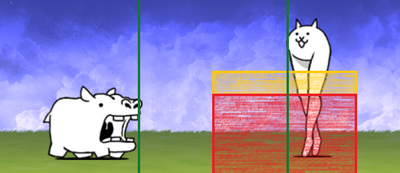
In the image above, it is easy to notice that Sexy Legs Cat's hitbox and detection box actually overlap. This is going to be true for all Cats and enemies without certain Special Abilities.
In this scenario, Sexy Legs is MOVING toward Hippoe. As soon as the yellow/red area reaches Hippoe's hitbox, Sexy Legs will be told to stop by its detection box, then it will start an attack animation which will cause its hitbox to activate for a frame and deal damage to Hippoe.
The same is true for Hippoe and all other Cats and Enemies who lack Long Distance or Omni Strike.
Standard unit on base[]
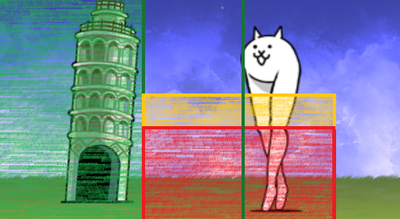
In this image, it is possible to see how Sexy Legs Cat interacts with a base. As you can see, the base's hurtbox continues far behind its sprite, while it starts slightly to the right of it.
Since Sexy Legs' detection box has reached the base's hurtbox, Sexy Legs is STANDING STILL. Since it is not moving, Sexy Legs is able to attack and cause damage to the base by having his hitbox activate during an attack animation, which happens every few seconds (indicated in this wiki by attack frequency).
A base's hurtbox stays after the battle is won, meaning that Sexy Legs will never advance any further.
Long Distance unit vs any unit[]
Things get complicated with Long Distance Cats and enemies.
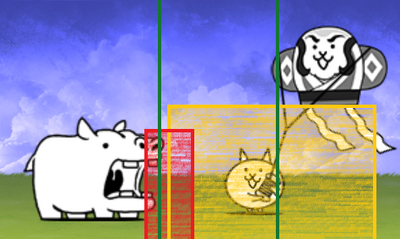
As shown in the picture above, the thing that changed is the position of the hitbox. In this case, Kite Cat's hitbox is already overlapping with Hippoe's hurtbox, so does this mean that Kite Cat is standing still? The answer is NO, because her detection box has not reached Hippoe yet. Kite Cat is actually still moving and will only stop once her yellow area reaches Hippoe. Once that happens, Kite will attack and hit the area indicated in red, rather than the area between the two.
If a Zoge were to un-burrow right now, such that his hurtbox barely overlaps with the back of Kite Cat's detection box, then Kite would attack and actually miss the Zoge, as Kite's hitbox doesn't cover her own hurtbox, but Hippoe would get hit (assuming it doesn't move). Zoge, on the other hand, would be able to freely and safely hit Kite.
Long Distance unit on base[]
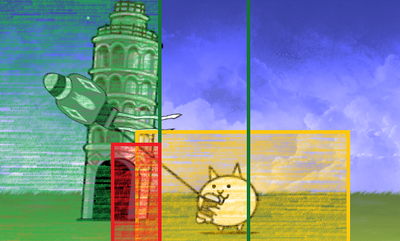
When dealing with bases, units with Long Distance use the closest part of their hitbox to detect them, instead of their range. In simpler words, Long Distance units get very close to the enemy base if they have a small blindspot, while they don't get as close as normal if they have the hitbox start further than the end of the detection box. Instead, in both cases, they align their hitbox to hit the base and anything behind. This basically nullifies the inner range, putting the unit at risk and locking single-target units to only hit the base, as it is always the closest target, unless overlapped.
Omni Strike unit vs any unit[]
Omni Strike, although a single ability, can work in different ways:
- Most Cats with Omni Strike have no piercing range. Such units include Mighty Thermae D-Lux, Piledriver Cat and a couple other units, usually anti-Zombie.
- All enemies and a couple of Cats that have Omni Strike also have a piercing range. Such units include Cat God the Great, Ken, Daboo of the Dead, Zollow and Mr. Puffington, to name a few. Sadly, there are no small and common units in this category, so Ken will be used in examples.
- Some Cats, such as Baby Garu, have less negative reach than the standard 320 and no piercing range, meaning that they act like regular units, except they have a negative blindspot, while they gain nothing in return, making the ability a purely negative one.
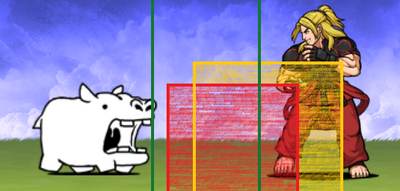
As this image shows, Ken, who has Omni Strike WITH piercing range, has a hitbox that extends further than the detection box, but still covers the hurtbox. For this reason, in this scenario, Ken works exactly like Kite Cat, but doesn't have a blindspot to worry about.
Since his negative reach is lower than 320, however, Ken still has a negative blindspot to worry about, meaning that a Zoge could un-burrow into this blindspot and still freely hit him, just like with Kite.
Units with a negative reach higher than 320 (negative piercing range) have the ability to hit enemies that are behind them, as long as someone else is triggering their detection box, meaning that if a Zoge un-burrows behind Pilediver Cat's detection box, but touches her hitbox, Pilediver will still advance forward like nothing. For this reason, the negative range on the hitbox is only useful to intercept units by chance, so, in most cases, it is very wide to increase said chances.
Omni Strike unit on base[]
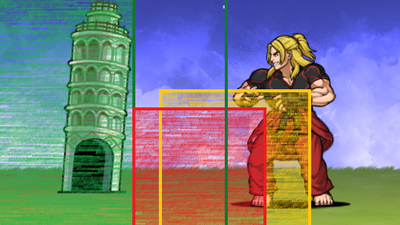
Despite what it may look like, in this image Ken is actually standing still with no intention of ever walking forwards again. When encountering a base, Omni Strike units detect it with the front of their hitbox, unlike Long Distance cats and enemies who use the back of the hitbox instead. This means that Omni Strike units stay further from the base than an enemy, unless the Omni Strike unit has no piercing range. This gives units with high piercing range like Heavenly Herald Papuu or Cat God the Great a massive advantage in standing range when close to a base. Even in this case, Ken is standing 100px further from the base than he would to an enemy, making him that much safer.
Some units change their effective range for multiple hits of the Omni Strike. In this case, the first hit of the multi-hit is the only one that counts when it comes to distance to stay from the base.
Trivia[]
- In version 6.0 of BCJP, hurtboxes would not disappear when units were being knocked back, which had some serious repercussions for rusher-class Cats. The change was reverted in BCEN 6.0 and subsequent versions of BCJP.
- Before it became its distinct thing in version 6.10, Omni Strike was just another type of Long Distance and was commonly referred to as "negative Long Distance".

